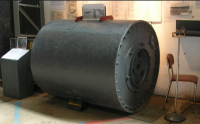








A bouncing bomb is a bomb designed to bounce to a target across water in a calculated manner to avoid obstacles such as torpedo nets, and to allow both the bomb's speed on arrival at the target and the timing of its detonation to be pre-determined, in a similar fashion to a regular naval depth charge.The inventor of the first such bomb was the British engineer Barnes Wallis, whose "Upkeep" bouncing bomb was used in the RAF's Operation Chastise of May 1943 to bounce into German dams and explode underwater, with effect similar to the underground detonation of the Grand Slam and Tallboy earthquake bombs, both of which he also invented.
A 'normal' bombing raid risked heavy casualties. Wallis developed in his mind a plan for a raid by a small, highly trained team of expert fliers, navigators, bombers etc who could fly so low that radar would not pick them up and hit, with pin-point accuracy, their target. In his mind, those targets should be the dams that held back the mighty waters of the Ruhr. If these dams were breached, the water would destroy anything in its path.
Wallis set himself the task of designing a bomb so special that it would break up the reinforced concrete that made up the Ruhr dams. The bomb needed to be dropped at an exceptionally low height so that it hit a dam, did not explode but sank into the water. At a given depth, a fuse would break and the bomb would explode. The shock waves created by the bomb would be accentuated underwater and, Wallis believed, would be enough to destroy the dam. The first tests of the bomb were done in a large indoors pool with a scaled-down bomb. The experimental indoors tests were a success.
When a life-size one was dropped under the greatest of secrecy in the waters off of the beaches of Kent, the first test was a failure (as were those that followed it) and MOD personnel remained sceptical about any success for the 'bouncing bomb'. Wallis believed that the plane, which came in unusually low, was flying too high and asked the crew to fly in even lower for the next test. His gamble, and the crew's piloting skills, worked - the bomb bounced and bounced so, in its imaginary situation, it would have cleared any nets that protected the dams in the Ruhr.
In May 1943, the Dambuster Raid took place. 617 Squadron, commanded by Guy Gibson, VC, attacked the Ruhr Dams using the bomb invented by Barnes Wallis. The actual physical impact of the raid will always be open to debate. The huge psychological impact of the raid, however, can never be doubted. Wallis, however, expressed his view that the raid, having cost eight Lancaster bomber crews out of nineteen, may not have been worth the losses.
Wallis also invented the 'Tallboy' bomb that was used to penetrate the U-boat pens on the west coast of France. He also developed one of the mainstays of Bomber Command - the Wellington bomber, used so often in bombing raids over Nazi Germany.